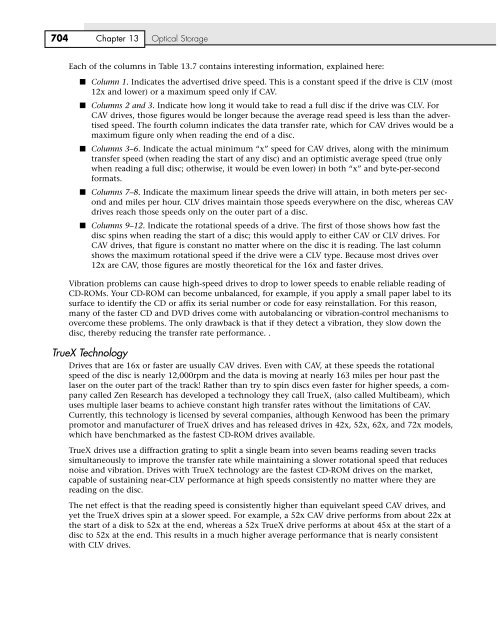Create successful ePaper yourself
Turn your PDF publications into a flip-book with our unique Google optimized e-Paper software.
704 Chapter <strong>13</strong> Optical Storage<br />
Each of the columns in Table <strong>13</strong>.7 contains interesting information, explained here:<br />
■ Column 1. Indicates the advertised drive speed. This is a constant speed if the drive is CLV (most<br />
12x and lower) or a maximum speed only if CAV.<br />
■ Columns 2 and 3. Indicate how long it would take to read a full disc if the drive was CLV. For<br />
CAV drives, those figures would be longer because the average read speed is less than the advertised<br />
speed. The fourth column indicates the data transfer rate, which for CAV drives would be a<br />
maximum figure only when reading the end of a disc.<br />
■ Columns 3–6. Indicate the actual minimum “x” speed for CAV drives, along with the minimum<br />
transfer speed (when reading the start of any disc) and an optimistic average speed (true only<br />
when reading a full disc; otherwise, it would be even lower) in both “x” and byte-per-second<br />
formats.<br />
■ Columns 7–8. Indicate the maximum linear speeds the drive will attain, in both meters per second<br />
and miles per hour. CLV drives maintain those speeds everywhere on the disc, whereas CAV<br />
drives reach those speeds only on the outer part of a disc.<br />
■ Columns 9–12. Indicate the rotational speeds of a drive. The first of those shows how fast the<br />
disc spins when reading the start of a disc; this would apply to either CAV or CLV drives. For<br />
CAV drives, that figure is constant no matter where on the disc it is reading. The last column<br />
shows the maximum rotational speed if the drive were a CLV type. Because most drives over<br />
12x are CAV, those figures are mostly theoretical for the 16x and faster drives.<br />
Vibration problems can cause high-speed drives to drop to lower speeds to enable reliable reading of<br />
CD-ROMs. Your CD-ROM can become unbalanced, for example, if you apply a small paper label to its<br />
surface to identify the CD or affix its serial number or code for easy reinstallation. For this reason,<br />
many of the faster CD and DVD drives come with autobalancing or vibration-control mechanisms to<br />
overcome these problems. The only drawback is that if they detect a vibration, they slow down the<br />
disc, thereby reducing the transfer rate performance. .<br />
TrueX Technology<br />
Drives that are 16x or faster are usually CAV drives. Even with CAV, at these speeds the rotational<br />
speed of the disc is nearly 12,000rpm and the data is moving at nearly 163 miles per hour past the<br />
laser on the outer part of the track! Rather than try to spin discs even faster for higher speeds, a company<br />
called Zen Research has developed a technology they call TrueX, (also called Multibeam), which<br />
uses multiple laser beams to achieve constant high transfer rates without the limitations of CAV.<br />
Currently, this technology is licensed by several companies, although Kenwood has been the primary<br />
promotor and manufacturer of TrueX drives and has released drives in 42x, 52x, 62x, and 72x models,<br />
which have benchmarked as the fastest CD-ROM drives available.<br />
TrueX drives use a diffraction grating to split a single beam into seven beams reading seven tracks<br />
simultaneously to improve the transfer rate while maintaining a slower rotational speed that reduces<br />
noise and vibration. Drives with TrueX technology are the fastest CD-ROM drives on the market,<br />
capable of sustaining near-CLV performance at high speeds consistently no matter where they are<br />
reading on the disc.<br />
The net effect is that the reading speed is consistently higher than equivelant speed CAV drives, and<br />
yet the TrueX drives spin at a slower speed. For example, a 52x CAV drive performs from about 22x at<br />
the start of a disk to 52x at the end, whereas a 52x TrueX drive performs at about 45x at the start of a<br />
disc to 52x at the end. This results in a much higher average performance that is nearly consistent<br />
with CLV drives.
















